The AMD Ryzen 5 5600X processor, built on the Zen 3 architecture, remains a remarkably capable and popular CPU for mid-range gaming and productivity builds, Its balance of 6 cores, 12 threads, and excellent single-core performance provides a solid foundation for a powerful and cost-effective system. However, unlocking the full potential of this processor requires pairing it with an equally capable motherboard.
Choosing the right motherboard is one of the most critical decisions when building a PC. It dictates your system’s connectivity, expansion capabilities, and overall stability. For the Ryzen 5 5600X, the primary choices lie within the AMD 500-series chipsets, specifically B550 and X570. This guide provides an objective, informational breakdown of prominent motherboards for the Ryzen 5 5600X, updated with current specifications and market context.
Understanding the Ryzen 5 5600X Platform in 2025
The Ryzen 5 5600X uses the AM4 socket, a platform that has served AMD for several generations. While AMD has since moved on to the newer AM5 socket for its latest processors, the AM4 platform offers tremendous value. The maturity of the platform means that motherboards are feature-rich, stable, and more affordable than their AM5 counterparts. For anyone building a new PC on a budget or upgrading an existing AM4 system, the 5600X and a compatible motherboard present a logical and powerful combination. If you’re weighing your options, understanding the differences between motherboard generations, like in this B550 vs X570 comparison, is a crucial first step.
Comparison of Top Motherboards for Ryzen 5 5600X
This table offers a high-level overview of the key specifications for the motherboards detailed in this guide. This allows for a quick assessment of features to help narrow down the options based on your specific requirements.
| Feature | ASUS ROG Strix B550-F Gaming WIFI II | MSI MAG B550 TOMAHAWK MAX WIFI | GIGABYTE B550 AORUS PRO V2 | ASUS TUF Gaming B550M-PLUS WIFI II | MSI MEG X570S UNIFY-X MAX | ASUS ROG Crosshair VIII Dark Hero |
| Form Factor | ATX | ATX | ATX | Micro-ATX | ATX | ATX |
| Chipset | B550 | B550 | B550 | B550 | X570S (Fanless) | X570 |
| VRM Phases | 12+2 | 10+2+1 | 12+2 | 8+2 | 16+2 (90A) | 14+2 (90A) |
| Memory Slots | 4 x DDR4 | 4 x DDR4 | 4 x DDR4 | 4 x DDR4 | 2 x DDR4 | 4 x DDR4 |
| Max Memory | 128GB | 128GB | 128GB | 128GB | 64GB | 128GB |
| PCIe 4.0 x16 | 1 | 1 | 1 | 1 | 2 (x16 or x8/x8) | 2 (x16 or x8/x8) |
| M.2 Slots | 1x Gen4, 1x Gen3 | 1x Gen4, 1x Gen3 | 1x Gen4, 1x Gen3 | 1x Gen4, 1x Gen3 | 6 (4x Gen4, 2x Gen3) | 2x Gen4 |
| SATA Ports | 6 | 6 | 6 | 4 | 6 | 8 |
| Ethernet | Intel 2.5Gb | Realtek 2.5Gb | Realtek 2.5Gb | Realtek 2.5Gb | Realtek 2.5Gb | 2.5Gb & 1Gb |
| Wi-Fi | Wi-Fi 6E | Wi-Fi 6E | No | Wi-Fi 6 | No | Wi-Fi 6 |
| Audio Codec | ROG SupremeFX S1220A | Realtek ALC897 | Realtek ALC1220-VB | Realtek S1200A | Realtek ALC4080 | ROG SupremeFX S1220 |
| BIOS Flash | Yes | Yes | Yes (Q-Flash Plus) | Yes | Yes | Yes |
Note: The table above is a summary. Some specifications for the remaining boards (Strix B550-A, B550M AORUS PRO-P, Crosshair VIII Formula, MEG X570 GODLIKE) are similar to those listed and are detailed below.
In-Depth Motherboard Reviews
Here we explore each motherboard in detail, providing an objective analysis of its features and its place in the current market. Knowing how to find your motherboard model in Windows 11 can be useful if you’re planning an upgrade.
1. ASUS ROG Strix B550-F Gaming WIFI II
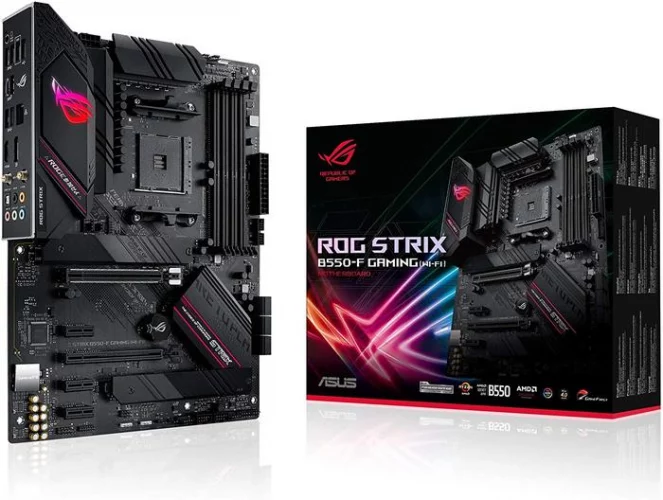
The ASUS ROG Strix B550-F Gaming WIFI II is an updated version of a highly popular motherboard, refined with modern connectivity features. It represents a premium B550 option aimed at gamers who want a robust feature set without moving to the X570 chipset.
Key Specifications
- Form Factor: ATX
- VRM: 12+2 teamed power stages
- Connectivity: 1x PCIe 4.0 x16, 1x PCIe 4.0 M.2, Intel 2.5Gb Ethernet, Wi-Fi 6E
- Audio: ROG SupremeFX S1220A with dual Op Amps
- Special Features: Two-Way AI Noise Cancelation, BIOS FlashBack™, Pre-mounted I/O shield
Objective Analysis
This board provides a very well-rounded package. The 12+2 power stage design is more than sufficient for the Ryzen 5 5600X, even with overclocking. The inclusion of Wi-Fi 6E and 2.5Gb Ethernet makes it future-proof for networking. The SupremeFX audio is a noticeable step up from standard Realtek codecs, providing clearer audio for gaming and media consumption.
Current Status & Alternatives (2025)
This model is still widely available. It is an excellent, balanced choice for a new Ryzen 5 5600X build. For users who do not require Wi-Fi, a non-Wi-Fi version may be available at a lower cost, or they might consider the GIGABYTE B550 AORUS PRO V2 for a similar feature set without the wireless connectivity.
2. MSI MAG B550 TOMAHAWK MAX WIFI
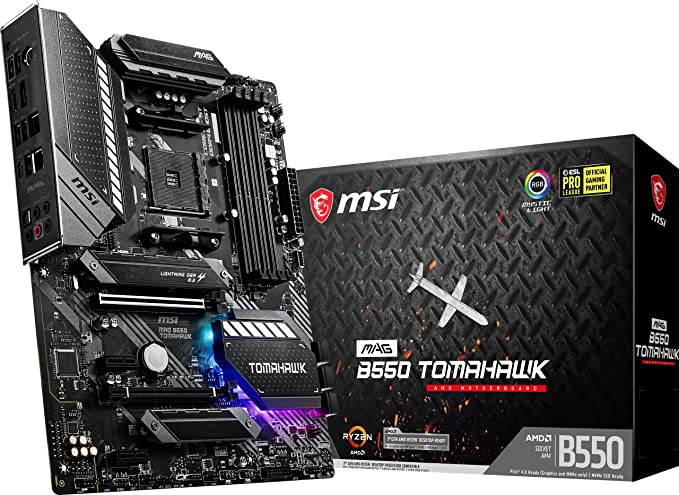
MSI’s TOMAHAWK series has a long-standing reputation for offering exceptional value and performance, and the B550 TOMAHAWK MAX WIFI continues this legacy. It’s a direct competitor to the ASUS Strix line, often appealing to users with its strong power delivery and practical features.
Key Specifications
- Form Factor: ATX
- VRM: 10+2+1 Duet Rail Power System
- Connectivity: 1x PCIe 4.0 x16, 1x PCIe 4.0 M.2, Realtek 2.5Gb Ethernet, Wi-Fi 6E
- Audio: Realtek ALC897 Codec
- Special Features: Extended Heatsink Design, M.2 Shield Frozr, BIOS Flash Button
Objective Analysis
The TOMAHAWK’s main strength lies in its robust thermal and power delivery systems at a competitive price point. The extended heatsinks on the VRM ensure that power delivery remains stable under load, which is beneficial for system longevity. While its Realtek ALC897 audio codec is more mainstream than the SupremeFX on the Strix, it is perfectly adequate for most gaming and general use cases. The inclusion of Wi-Fi 6E and 2.5Gb LAN keeps it current.
Current Status & Alternatives (2025)
This is another highly available and recommended model. Its direct competitor is the ASUS ROG Strix B550-F. The choice between them often comes down to brand preference, aesthetics, or minor feature differences like the audio codec.
3. ASUS ROG Strix B550-A Gaming
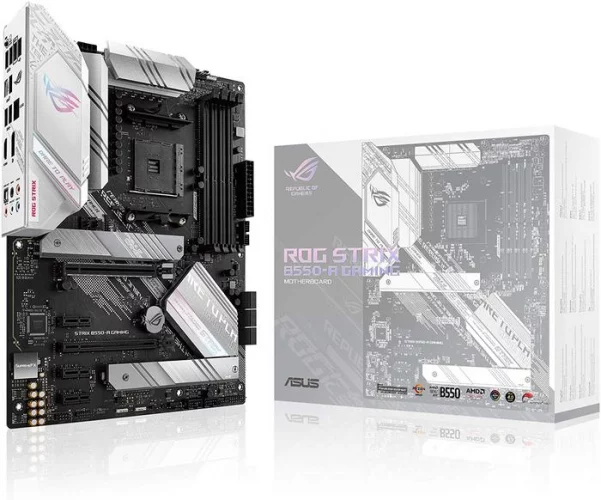
The ASUS ROG Strix B550-A Gaming is functionally very similar to its B550-F counterpart but features a striking silver and white color scheme. It’s designed for builders creating a PC with a white aesthetic.
Key Specifications
- Form Factor: ATX
- VRM: 12+2 teamed power stages
- Connectivity: 1x PCIe 4.0 x16, 1x PCIe 4.0 M.2, Intel 2.5Gb Ethernet
- Audio: ROG SupremeFX S1220A
- Special Features: White/silver aesthetic, Two-Way AI Noise Cancelation, BIOS FlashBack™
Objective Analysis
This motherboard offers the same excellent performance and features as the B550-F, including a robust VRM, high-quality audio, and fast networking. It does not include Wi-Fi out of the box, which is a key differentiator. Its primary appeal is visual, making it a top choice for aesthetically focused builds, especially in one of the many popular white PC cases.
Current Status & Alternatives (2025)
This board remains a popular choice for its looks and is readily available. If Wi-Fi is needed, a PCIe adapter can be added. For those not committed to a white theme, the B550-F Gaming WIFI II offers more connectivity for a similar price.
4. Gigabyte B550M AORUS PRO-P
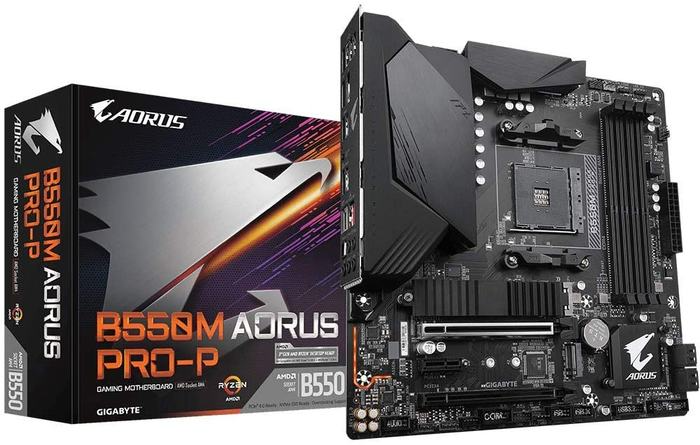
The Gigabyte B550M AORUS PRO-P is a Micro-ATX motherboard that packs a surprising number of features into its smaller form factor. It is an ideal choice for compact builds that do not compromise on performance.
Key Specifications
- Form Factor: Micro-ATX
- VRM: 10+2 Phases Digital Twin Power Design with 50A DrMOS
- Connectivity: 1x PCIe 4.0 x16, 1x PCIe 4.0 M.2, Realtek 2.5GbE LAN
- Audio: Realtek ALC1200 Codec
- Special Features: Enlarged VRM Heatsinks, Q-Flash Plus, Dual M.2 slots
Objective Analysis
For a Micro-ATX board, the B550M AORUS PRO-P boasts a very strong power delivery system, making it fully capable of handling the Ryzen 5 5600X. The inclusion of 2.5GbE LAN is a premium feature in this form factor. It provides a good balance between size, performance, and cost. Understanding the difference between Micro-ATX vs Mini-ITX vs ATX is key to choosing the right size for your build.
Current Status & Alternatives (2025)
This model is an excellent and available option for Micro-ATX builds. Its primary competitor is the ASUS TUF Gaming B550M-PLUS, which offers a similar feature set. The choice may depend on I/O preferences or brand loyalty.
5. ASUS TUF Gaming B550M-PLUS WIFI II
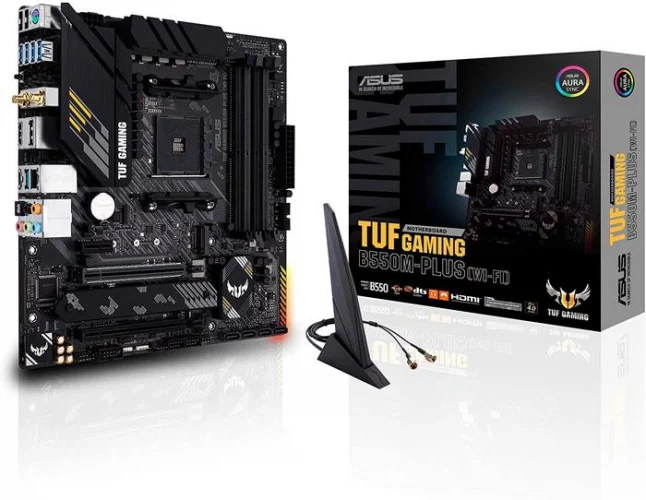
The ASUS TUF Gaming series is known for its durability and military-grade components. The B550M-PLUS WIFI II brings this philosophy to the Micro-ATX form factor, offering a resilient and feature-rich option for compact builds.
Key Specifications
- Form Factor: Micro-ATX
- VRM: 8+2 DrMOS power stages
- Connectivity: 1x PCIe 4.0 x16, 1x PCIe 4.0 M.2, Wi-Fi 6, 2.5 Gb Ethernet
- Audio: Realtek S1200A Codec with DTS Custom
- Special Features: TUF components, Two-Way AI Noise Cancelation, BIOS FlashBack™
Objective Analysis
This board is a workhorse. While its 8+2 power stage design is less elaborate than some ATX boards, it is perfectly adequate for the 65W TDP of the Ryzen 5 5600X. It delivers both Wi-Fi 6 and 2.5Gb LAN, ensuring excellent connectivity. The TUF branding emphasizes reliability, with high-quality chokes and capacitors designed for longevity.
Current Status & Alternatives (2025)
The TUF Gaming B550M-PLUS WIFI II is a popular and available choice. It competes directly with the Gigabyte B550M AORUS PRO-P. The ASUS board includes Wi-Fi, which could be the deciding factor for many builders.
6. MSI MEG X570S UNIFY-X MAX
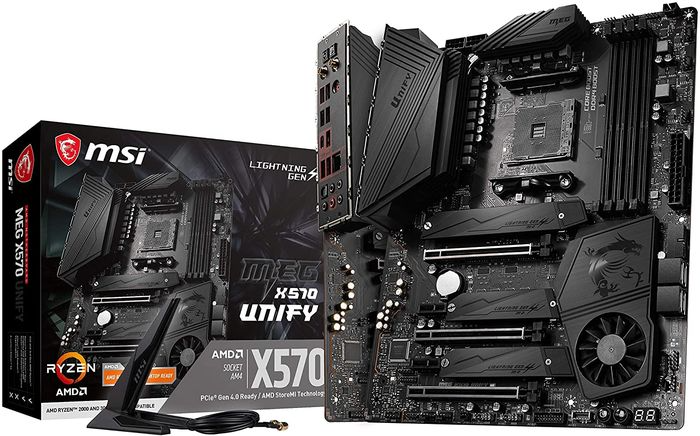
Moving into the enthusiast X570 chipset, the MSI MEG X570S UNIFY-X MAX is a specialized motherboard. The ‘S’ in X570S denotes a revised chipset that runs cooler and allows for fanless, silent heatsink designs. This board is geared toward overclockers and performance enthusiasts.
Key Specifications
- Form Factor: ATX
- VRM: 16+2 phases with 90A Smart Power Stages
- Connectivity: 2x PCIe 4.0 x16, 6x M.2 slots (4x Gen4), 2.5GbE LAN
- Memory: 2x DDR4 DIMM slots (Optimized for overclocking)
- Special Features: Fanless chipset heatsink, Extreme OC focus, only two DIMM slots for signal integrity
Objective Analysis
This is not a typical motherboard for a standard Ryzen 5 5600X build. Its features are overkill for most users. The massive VRM and two-DIMM layout are designed for extreme memory overclocking records. The inclusion of six M.2 slots is exceptional and caters to users with massive, high-speed storage needs. For the average user, the trade-off of having only two memory slots is not ideal.
Current Status & Alternatives (2025)
This is a niche, high-end product that is largely discontinued or very difficult to find new. It was replaced by enthusiast-tier X670E boards on the AM5 platform. A more practical high-end alternative for a Ryzen 5 5600X would be the ASUS ROG Crosshair VIII Dark Hero, which offers better-balanced features.
7. ASUS ROG Crosshair VIII Dark Hero
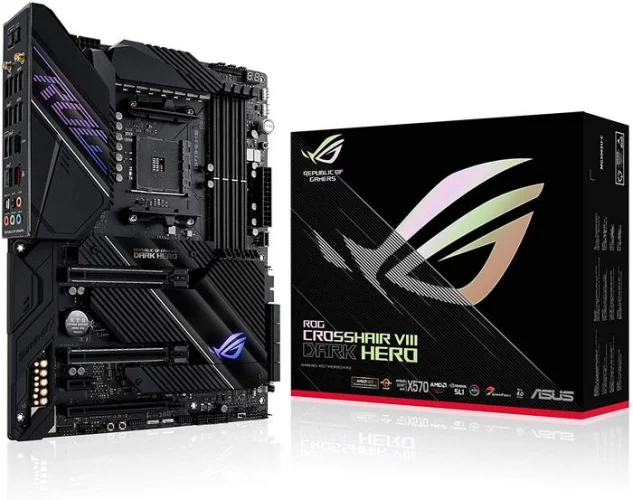
The ASUS ROG Crosshair VIII Dark Hero is a legendary high-end X570 motherboard. It was one of the first to feature a passive, fanless chipset heatsink, and its feature set is aimed squarely at enthusiasts who demand the best for the AM4 platform.
Key Specifications
- Form Factor: ATX
- VRM: 14+2 teamed power stages (90A)
- Connectivity: 2x PCIe 4.0 x16, 2x PCIe 4.0 M.2, 2.5Gb & 1Gb Ethernet, Wi-Fi 6
- Audio: ROG SupremeFX S1220 with ESS ES9023P DAC
- Special Features: Passive chipset cooling, Dynamic OC Switcher, premium components throughout
Objective Analysis
The Dark Hero is an exceptional piece of engineering. The power delivery is robust enough for the most powerful Ryzen 9 processors, meaning it handles the 5600X with ease. Its dual LAN ports, high-end audio implementation, and extensive cooling options provide a premium experience. However, much like the Unify-X, its feature set is far beyond what a typical Ryzen 5 5600X user needs.
Current Status & Alternatives (2025)
The Crosshair VIII Dark Hero is generally discontinued and commands high prices on the second-hand market due to its reputation. For users considering this level of board, it is more practical to invest that budget into a modern AM5 platform with a DDR5 motherboard and a newer CPU. A more reasonable AM4 alternative would be the ASUS ROG Strix B550-F Gaming.
8. ASUS ROG X570 Crosshair VIII Formula
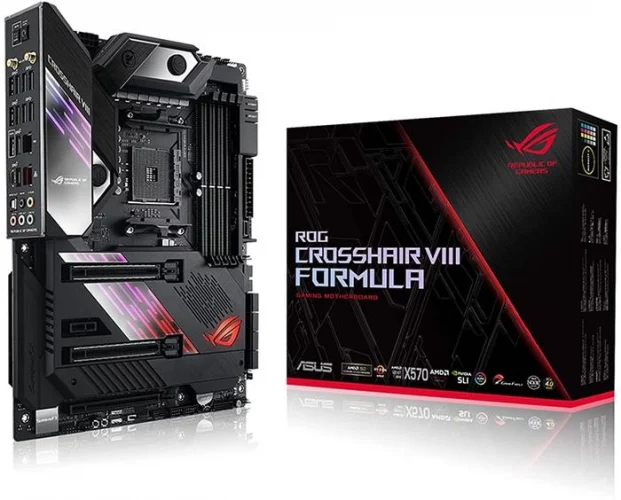
The Formula takes the Crosshair VIII platform a step further by integrating a custom CrossChill EK III VRM block, designed for inclusion in a custom water-cooling loop. This is a highly specialized board for dedicated water-cooling enthusiasts.
Key Specifications
- Form Factor: ATX
- VRM: 14+2 power stages with CrossChill EK III water block
- Connectivity: 2x PCIe 4.0 x16, 2x PCIe 4.0 M.2, 5Gb & 1Gb Ethernet, Wi-Fi 6
- Audio: ROG SupremeFX S1220
- Special Features: Integrated water block, LiveDash OLED screen, full-coverage armor
Objective Analysis
The defining feature is the VRM water block. If you are not building a custom water-cooled PC, the primary benefit of this board is lost. It offers top-tier features like 5Gb LAN and an onboard OLED screen, but these come at a significant cost premium. For a Ryzen 5 5600X, this level of cooling and features is entirely unnecessary. Knowing how to watercool a GPU is just the start for a build centered around this board.
Current Status & Alternatives (2025)
Like the Dark Hero, the Formula is a last-generation enthusiast product that is now discontinued. Its high initial cost and specialized nature make it a rarity. Users interested in custom water cooling would be better served by looking at current-generation AM5 motherboards with similar features.
9. MSI MEG X570 GODLIKE
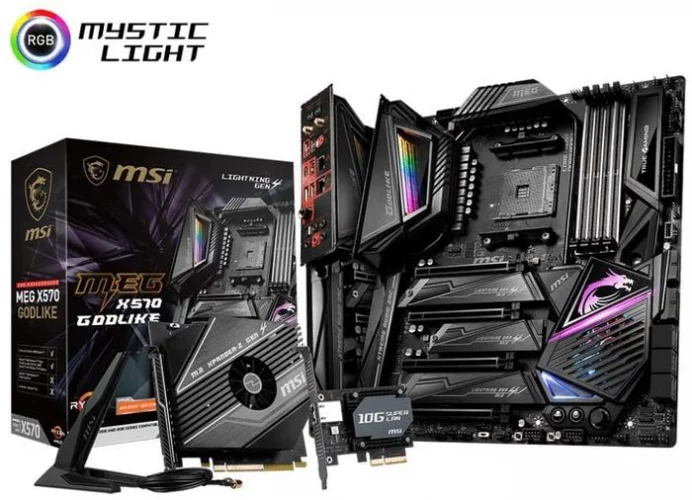
As the name implies, the MSI MEG X570 GODLIKE was MSI’s flagship, “everything but the kitchen sink” motherboard for the X570 platform. It came in an E-ATX form factor and was packed with an extreme feature set and accessories.
Key Specifications
- Form Factor: E-ATX
- VRM: 14+4+1 Phase Digital Power Design
- Connectivity: 3x PCIe 4.0 x16, 3x M.2 slots, Dual LAN (2.5Gb + 1Gb), Wi-Fi 6
- Audio: Xtreme Audio DAC with dual audio processors
- Special Features: Dynamic Dashboard OLED, M.2 Xpander-Z Gen4 card (for two extra M.2 drives), 10G Super LAN card included
Objective Analysis
The GODLIKE was a showcase of technology. It included not just premium onboard features but also add-in cards for even more connectivity. The E-ATX size means it won’t fit in standard ATX PC cases. For a Ryzen 5 5600X, this board is the definition of overkill; its power and features are designed for heavily overclocked Ryzen 9 processors and users who need maximum I/O.
Current Status & Alternatives (2025)
This motherboard is discontinued and was extremely expensive even when new. It is a collector’s item more than a practical choice. A user could build an entire high-end AM5 system for the price this board still commands on the used market.
10. GIGABYTE B550 AORUS PRO V2
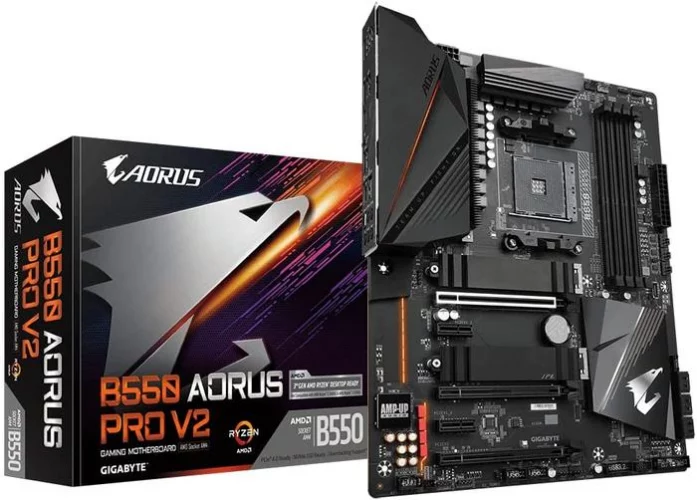
The GIGABYTE B550 AORUS PRO V2 is a strong, mid-to-high-end ATX motherboard that focuses on delivering core performance features without the added cost of extras like Wi-Fi.
Key Specifications
- Form Factor: ATX
- VRM: 12+2 Phases Digital Twin Power Design with 50A DrMOS
- Connectivity: 1x PCIe 4.0 x16, 1x PCIe 4.0 M.2, 2.5GbE LAN
- Audio: Realtek ALC1220-VB Codec
- Special Features: Advanced thermal design with Fins-Array Heatsink, Q-Flash Plus, Dual M.2 slots with thermal guards
Objective Analysis
This board is an excellent, no-nonsense choice for a wired gaming setup. It has a very capable VRM and thermal solution, ensuring stable performance for the Ryzen 5 5600X. The audio quality is a step above entry-level boards, and the 2.5GbE LAN is a great inclusion for fast network transfers. By omitting Wi-Fi, it offers a strong core feature set at a very competitive price point.
Current Status & Alternatives (2025)
This model is still a great choice and is readily available. It is a perfect option for users who have a reliable wired internet connection and want to invest in robust power delivery and cooling. Its main competitor is the MSI MAG B550 TOMAHAWK (non-WIFI version) or the ASUS ROG Strix B550-A Gaming for those wanting a white aesthetic.
Key Factors for Selecting a Ryzen 5 5600X Motherboard
When making your choice, consider these critical factors. The priority of each will depend on your specific needs and budget.
Chipset Comparison: B550 vs. X570
- B550: This is the ideal chipset for the vast majority of Ryzen 5 5600X users. It provides one PCIe 4.0 x16 slot for the graphics card and one PCIe 4.0 M.2 slot for a primary NVMe SSD, which is all most users need. The chipset’s own communication lanes are PCIe 3.0, which results in less heat and allows for simpler, often more affordable motherboard designs.
- X570: This enthusiast chipset offers more PCIe 4.0 lanes. This means it can support multiple PCIe 4.0 GPUs and multiple PCIe 4.0 M.2 SSDs running at full speed simultaneously. Early X570 boards required a small chipset fan, though later “X570S” models were passively cooled. For a Ryzen 5 5600X, the extra features of X570 are generally not necessary unless you have a specific need for more than one Gen4 device.
VRM and Power Delivery: Fueling the CPU
The Voltage Regulator Module (VRM) converts the 12V power from your PSU into the precise, low voltage your CPU needs. A more robust VRM with more power phases and better cooling ensures stable voltage under load, which is critical for performance and overclocking. While the 65W Ryzen 5 5600X is not particularly demanding, a quality VRM is still a hallmark of a good motherboard and contributes to system longevity. All the boards on this list have VRMs that are more than capable of handling the 5600X.
Form Factor: ATX, Micro-ATX, and Mini-ITX
The size of the motherboard, or its form factor, determines case compatibility and expansion options.
- ATX: The standard size, offering the most PCIe slots and connectivity features.
- Micro-ATX (mATX): A shorter board that fits in more compact cases but has fewer PCIe slots.
- Mini-ITX (mITX): The smallest form factor, designed for tiny PCs, usually with only one PCIe slot.
The choice depends on your desired PC size. Building in a compact micro-atx case can save space while still allowing for a powerful build.
Connectivity Needs: PCIe, M.2, and USB
Consider your current and future needs. Do you need Wi-Fi? How many USB devices do you use? How many PCIe slots do you need for sound cards, capture cards, or other expansion? Ensure the rear I/O and internal headers meet your requirements. Most B550 boards offer an excellent mix of modern connectivity that will satisfy the majority of users.
Frequently Asked Questions (FAQ)
Do B550 and X570 motherboards need a BIOS update for the Ryzen 5 5600X?
When the Ryzen 5000 series launched, many existing 500-series boards required a BIOS update. However, virtually all new stock of B550 and X570 motherboards will ship with a compatible BIOS. Furthermore, nearly every board on this list features a BIOS Flashback function, which allows you to update the motherboard BIOS with just a USB stick and a power supply, without needing an older CPU installed.
Is a B550 or X570 motherboard a better choice for the Ryzen 5 5600X?
For over 95% of users, a B550 motherboard is the better choice. It provides all the necessary PCIe 4.0 connectivity for a primary GPU and SSD at a more reasonable price point. An X570 board is only necessary if you have a specific professional or enthusiast use case that requires multiple PCIe 4.0 expansion cards or M.2 drives.
What is the best RAM to pair with a Ryzen 5 5600X?
The Ryzen 5000 series CPUs perform optimally with dual-channel DDR4 RAM at speeds between 3200MHz and 3600MHz. A 16GB (2x8GB) or 32GB (2x16GB) kit of DDR4-3600 CL16 or CL18 RAM is widely considered the “sweet spot” for performance and value. You can explore a curated list of the best RAM for the Ryzen 5 5600X for specific recommendations.
Is building a new PC with a Ryzen 5 5600X still a good idea?
Yes, for budget-to-mid-range builds, it remains an excellent choice. The combination of a 5600X CPU, a B550 motherboard, and DDR4 RAM offers fantastic performance-per-dollar that is hard to beat. While the newer AM5 platform is more powerful, it also comes at a significantly higher cost. For gamers targeting 1080p or 1440p resolutions, an AM4-based system with a 5600X provides a high-quality experience without breaking the bank.
How many M.2 slots are sufficient for a gaming PC?
For most gaming PCs, two M.2 slots are perfectly sufficient. One slot can be used for a fast PCIe 4.0 NVMe SSD for the operating system and frequently played games, while the second slot can be used for a larger, more affordable PCIe 3.0 or SATA M.2 SSD for additional game storage. You can learn more about how many M.2 slots are on a motherboard and decide what’s best for your storage needs.

Holding a Ph.D. in Computer Science, Dr. Alistair Finch is our chief PC Component Benchmark Analyst. He provides meticulous, data-driven analysis of CPUs and GPUs, moving beyond marketing claims to reveal their true performance. His guides help readers understand the intricate relationship between hardware architecture and real-world gaming frame rates.
